Anatomy of a Farce
Anatomy of a Farce
In the previous entry we’ve learned of an 18th century farce, High Life Below Stairs, that contains a joke. Sir Walter Scott’s diary has an entry noting the joke in that farce, “Who wrote Shakespeare” to which replies include “Ben Jonson” and also Scott himself.
That joke, and High Life Below Stairs are not new topics in Shakespeare Authorship. In fact, it is noted in Wikipedia’s history of the authorship question. Here we can find the Stratfordian position on the joke Scott reported.
R.C. Churchill says that the first documented expression of doubt about Shakespeare’s authorship came in 1760, in a farce entitled High Life Below Stairs in which a Miss Kitty poses the question: “Who wrote Shakespeare?” The Duke responds “Ben Jonson.” Lady Bab then cries; “Oh, no! Shakespeare was written by one Mr. Finis, for I saw his name at the end of the book.” Churchill writes that, while not a very “profound” joke, there “must have been, in the mid-eighteenth century, a certain amount of discussion as to the authenticity of the traditional authorship of Shakespeare, and the substitution of Ben Jonson is significant.”[28]…
Shakespearean scholars have seen nothing in these works to suggest genuine doubts about Shakespeare’s authorship, since they are all presented as comic fantasies. The scene from High Life Below Stairs simply ridicules the stupidity of the characters, as Samuel Schoenbaum notes, adding that, “the Baconians, who discern in Townley’s farce an early manifestation of the anti-Stratfordian creed, have never been remarkable for their sense of humour”
The orthodox position is that comedies don’t contain allusions to real events. And besides, Baconians had no sense of humor. Schoenbaum’s position is laughable, and is easily refuted.
High Life Below Stairs was a very popular farce. It remained in the repertory for 150 years. It was printed in many editions, including French and German.
Examining the “Who wrote Shikspur?” joke across the many editions of the play turns up an interesting discrepancy. The joke as printed beginning with the first edition and then into many subsequent editions differs from the joke as printed in editions derived from the “acting copy,” which to the best of my investigations was not printed until 1826.
Here is the joke as printed in the 1826 “acting copy.”
click to enlarge
Now, here is the joke as printed in the 1759 first edition. Notice, two lines are missing, spoken by Sir Harry’s servant and the Duke’s servant.
click to enlarge
What seems to be an authorship joke in the 19th century acting copy printing – Q. Who wrote Shikspur? A. Ben Jonson or Kolly Kibber, is emasculated into a possible simple misinterpretation of “Shikspur” as the name of the book, and not the author. We now have lots of questions. Was this “Ben Jonson” punch line spoken on stage in the 18th century? Or is it a later 19th century addition?
We’ll put these questions aside for a moment and take a look at the play for obvious other authorship allusions.
High Life Below Stairs is about a group of servants who put on the airs of their masters. One of their masters disguises himself as an “Essex cottager” to spy on his servants and learn which are stealing him blind. The various servants in the farce address each other by their master’s names and titles, similar to the tradition seen in the recent Downton Abbey serial drama. The lines in the farce spoken by the “Duke” belong to the Duke’s servants. The Duke himself is not a character in the play.
Rambler likes to say that when you encounter something in a play that has no connection whatsoever to what has preceded you have a candidate for an allusion. In the following excerpt here the Duke’s servant is talking to Sir Harry’s servant and his remarks following “hark ye” are seemingly out of the blue.
click to enlarge
The Duke’s servant is telling Sir Harry that there are topics not to be discussed “Mum!” “bill depending…House…Ministry” all sound like political reasons for keeping mum. “mind the Stops of the Great Fiddle” recalls Hamlet.
‘Tis as easy as lying: govern these ventages with
your lingers and thumb, give it breath with your
mouth, and it will discourse most eloquent music.
Look you, these are the stops.” III,iii
Now when a character from nowhere says there are a topics that cannot be discussed, that is pretty much a red flag that an allusion to the forbidden topic is coming next. Here’s Sir Duke’s comment again, with Sir Harry’s servant’s response after the Duke’s servant departs.
click to enlarge
We’ve just learned that the Duke’s servant was “but the other day” a country Cow-boy who couldn’t read. He was then “bound Prentice to a Perriwig-maker” and then got into the Duke’s service where he now sets up a “fine Gentleman.” Si Harry’s ends with Cicero’s “O Tempora, O Mores!” from Ciceros second oration against Verres.
We have found Shaksper in the farce, and he is the Duke’s servant.
Over and over again as I read plays from the 16th century forward I see the allusions identify who the characters are at some point earlier in the play, and then most often it is at the end of the play, in the denouement, that we are told the information about whatever situation the play wishes to impart. The thesis here at The Festival Robe is that Shaksper’s name on the play represents his aping of his master. The denoument of High Life Below Stairs addresses this specific occurrence, and lays blame on master’s who don’t “act up to their Standard” and “affect every Thing that is ridiculous” for their subsequent aping by their servants.
click to enlarge
In the next installment of A Tour de Farce, we’ll examine the separate versions of the “Who wrote Shikspur?” joke in High Life Below Stairs. We have much mirth ahead of us!
more anon.

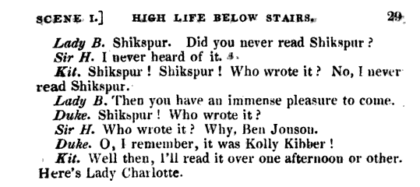
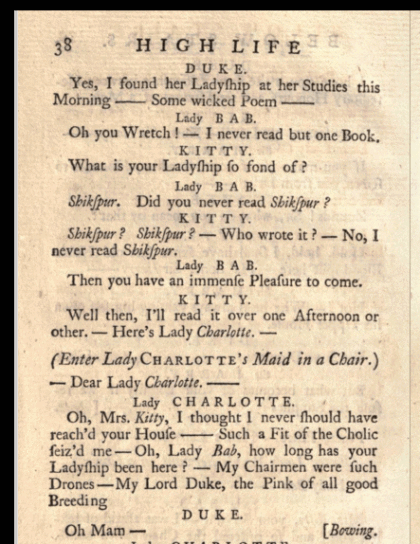
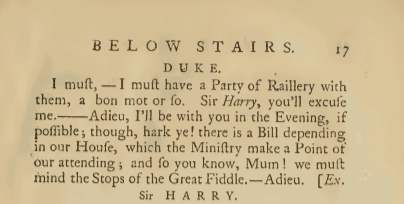
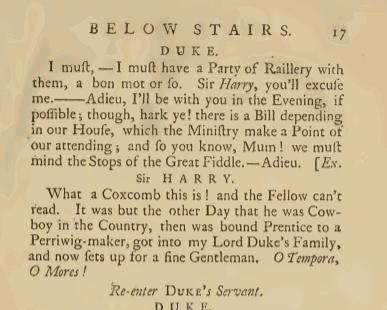
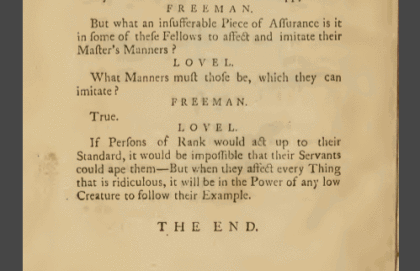

1 comment
*He was then “bound Prentice to a Perriwig-maker” and then got into the Duke’s service where he now sets up a “fine gentleman.”*
How did he get into the Duke’s service? He “got into my Duke’s family.”
In 1591 Katherine Sheldon became Oxford’s sister-in-law. Her uncle the late Sir Edward Arden was Shakspere’s cousin.
The sale of New Place & 1/2 tithes of Stratford to Shakspere and sale of property to Henry Condell all happened within family branching in descent from marriages of that sister-in-law’s aunt, Anne Savage Daston née Sheldon. In other words these transaction were conducted at the level of Oxford’s sister-in-law’s 1st cousins, their spouses and their kids.
That first husband of the aunt was Francis Savage (whose daughter-in-law Elizabeth née Hall later married the son of the guy who sold New Place and whose grandson John sold property to Condell and another cousin).
Savage was a 1st cousin of Margaret Russell Berkeley née Lygon whose…
…Son Thomas Russell was the overseer of Shakspere’s will
…Son the MP Sir Maurice Berkeley was arrested with Southampton and Sir Henry Neville on the night of Oxford’s death (<—that Berkeley and the overseer were closely raised half brothers was my research but everything else in this comment was long ago collected and analyzed by Nina Green. She also documented their relationship as 1/2 brothers but apparently did not realize he was the same man documented in the arrest with Southampton.)
…Step grandson Leonard Digges provided a commendatory poem for the 1st Folio
I am really impressed by these posts and agree with your view that Shakspere and Oxford were first working together and then fell out but William still had to be managed. I think this intersection of family is where Shakspere was initially recruited. I'm AShakespearean on Twitter.
Leave a Comment